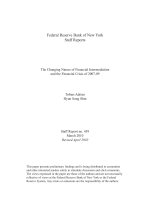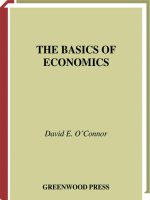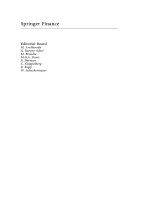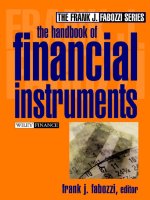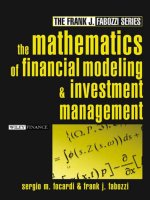Lecture no42 basics of financial options
Bạn đang xem bản rút gọn của tài liệu. Xem và tải ngay bản đầy đủ của tài liệu tại đây (461.85 KB, 22 trang )
Basics of Financial Options
Lecture No. 42
Chapter 13
Contemporary Engineering Economics
Copyright © 2016
th
Contemporary Engineering Economics, 6 edition
Park
Copyright © 2016 by Pearson Education, Inc.
All Rights Reserved
Chapter Opening Story
Travel is adventure. Prepare for the
unexpected.
o
o
o
Have you ever considered about buying a
trip insurance?
You want to minimize the downside risk
in case of cancelation or change in your
travel plan.
Can we think something like this in
protecting your investment in business?
th
Contemporary Engineering Economics, 6 edition
Park
Copyright © 2016 by Pearson Education, Inc.
All Rights Reserved
Financial Option Theory
•
•
•
Call option: A right (not obligation) to purchase a stock at a predetermined price
(exercise/strike price) before or on the date specified (maturity date)
Put option: A right (not obligation) to sell a stock at a predetermined price before or on
the date specified
Main issues
o
o
What is the value of this option?
How do you price this option?
th
Contemporary Engineering Economics, 6 edition
Park
Copyright © 2016 by Pearson Education, Inc.
All Rights Reserved
The Language of Options
Call
Put
Buy
The right to buy the underlying item at the strike price
The right to sell the underlying item at the strike price until
until the expiration date
the expiration date
Sell
Selling the right to buy the underlying item from you at
Selling the right to sell the underlying item to you until the
the strike price until the expiration date; known as
expiration date; known as writing a put
writing a call
th
Contemporary Engineering Economics, 6 edition
Park
Copyright © 2016 by Pearson Education, Inc.
All Rights Reserved
Process of Buying and Selling a Financial Option
th
Contemporary Engineering Economics, 6 edition
Park
Copyright © 2016 by Pearson Education, Inc.
All Rights Reserved
Option Notation
The following notaton will be used throughout the remainder of this text:
o
o
o
o
o
o
S = Underlying asset price today
0
S = Underlying asset price at expiration
T
K = Exercise price
T = Time to expiration
r = Risk-free rate
q = Continuous dividend yield
th
Contemporary Engineering Economics, 6 edition
Park
Copyright © 2016 by Pearson Education, Inc.
All Rights Reserved
Financial Options Terminologies
•
The Contracting Parties
o
Option seller
o
o
•
Option buyer
o
Taking a long position
The Right or Obligation
o
Option buyer
o
o
•
Taking a short position
Right to purchase
Option seller
o
Obligation to sell
Option Premium
o
o
o
o
o
o
Underlying asset (S)
Strike or exercise price (K)
Maturity (T)
Option premium (C)
Intrinsic value
Time value
th
Contemporary Engineering Economics, 6 edition
Park
Copyright © 2016 by Pearson Education, Inc.
All Rights Reserved
Financial Option Terminologies (continued)
•
Types of financial option
o American option
o An option that can be exercised earlier than its maturity date
o European option
•
o An option that can be exercised only at the maturity date
Payof (S = stock price, C = option premium)
o At the money, if S−C = K
o In the money, if S−C > K
o Out of money, if S−C < K
th
Contemporary Engineering Economics, 6 edition
Park
Copyright © 2016 by Pearson Education, Inc.
All Rights Reserved
Option Positions
th
Contemporary Engineering Economics, 6 edition
Park
Copyright © 2016 by Pearson Education, Inc.
All Rights Reserved
Example 13.1: Profit from Call Option
Given:
o Buying 100 shares (one contract)
o K = $625
o T = January 22,2016
o S = $579.11 (September 11, 2014)
o C = $45.60
o The initial investment = 100 × ($45.60) = $4,560
Find: Profit from exercising the European call option when the stock price is $700 at maturity
th
Contemporary Engineering Economics, 6 edition
Park
Copyright © 2016 by Pearson Education, Inc.
All Rights Reserved
Solution
Profit = ($700 - $625 - $45.60) × 100
= $2,940
th
Contemporary Engineering Economics, 6 edition
Park
Copyright © 2016 by Pearson Education, Inc.
All Rights Reserved
Example 13.2: Profit from Put Option
Given:
o Buying 100 shares (one contract)
o K = $580
o T = January 22,2016
o S = $579.11 (September 11, 2014)
o C = $58.30
o The initial investment = 100 × ($58.30) = $5,830
Find: Profit from exercising the European put option when the stock price is
$500 at maturity
th
Contemporary Engineering Economics, 6 edition
Park
Copyright © 2016 by Pearson Education, Inc.
All Rights Reserved
Solution
Profit = ($580 − $500 − $58.30) × 100
= $2,170
th
Contemporary Engineering Economics, 6 edition
Park
Copyright © 2016 by Pearson Education, Inc.
All Rights Reserved
Buy Option Strategies: Three Ways to Buy Call Options
Investor buys for Call Options
(a) Hold to Maturity and trade at
(1,000 shares) on Stock Z
strike price
Price: $55
(b) Trade for profit before option
Strike price: $60
expires
Premium: $750
(c) Let the option expire
th
Contemporary Engineering Economics, 6 edition
Park
If stock rises to 65
$5,000 − $750 = $4,250
If stock rises to 60
$0 − $750 = $750 loss
If stock rises to 62
$2,000 − $750 =$1,250
If stock rises to 60 1/2
$500 − $750 = $250 loss
If stock drops to 55
$750 loss
Copyright © 2016 by Pearson Education, Inc.
All Rights Reserved
Sell Option Strategies: Two Ways to Sell Call Options (Writing Call Options)
Investor owns 1,000 shares of Stock
Write 10 covered calls
(a) If stock rises to $57
Keep the premium
Z
Strike price: $60
No takes; option expires
($750 profit)
Price:
(b) If stock rises to $60
$750 (premium collected) − $750
$55/share
Buy 10 calls to cancel obligations and prevent
(premium on ofsetting calls) =
losing stocks.
Breakeven
Write 10 naked calls
(a) If stock rises to $57
Keep the premium ($750 profit)
Strike price: $60
No takes; option expires
Collect premium $750
Collect premium $750
Investor owns no share of Stock Z
th
Contemporary Engineering Economics, 6 edition
Park
(b) If stock rises to $65
$750 premium − $65,000 to buy
Option is exercised. You must buy 1,000
+ $60,000 = $4,250 net loss (You need to
shares to sell to meet call.
line up $64,250.)
Copyright © 2016 by Pearson Education, Inc.
All Rights Reserved
Example 13.3: Limiting Downside Risk
Given:
o
o
o
Option 1: Purchase 500 shares of GILD stock at $106
Option 2: Purchase 5 GILD five-month $110 calls at $8
Three possible scenarios for stock price at expiration
o $118 < ST
o $100 < ST < $118
o $100 > ST
Find: Profit or loss from three possible scenarios
th
Contemporary Engineering Economics, 6 edition
Park
Copyright © 2016 by Pearson Education, Inc.
All Rights Reserved
Solution
th
Contemporary Engineering Economics, 6 edition
Park
Copyright © 2016 by Pearson Education, Inc.
All Rights Reserved
Example 13.4: How to Use a Protective Put as Insurance
Given:
o Option 1: Buy QCOM at $76, without
o
owning a put for protection.
Option 2: Buy QCOM at $76 and buy a
QCOM six-month $75-put contract at
$4.40.
Find: Compare two options for risk exposure.
th
Contemporary Engineering Economics, 6 edition
Park
Copyright © 2016 by Pearson Education, Inc.
All Rights Reserved
Solution
o
o
Upside potential unlimited
Downside risk only $5.40
th
Contemporary Engineering Economics, 6 edition
Park
Copyright © 2016 by Pearson Education, Inc.
All Rights Reserved
How Option Premium Fluctuates
o
The greater the diference between the exercise price and the actual current price
(exercise price > actual current price) of the item, the cheaper the premium, because
there is less chance the option will be exercised.
o
The closer the expiration date of an out-of-the money option (where the market price is
higher than the strike price), the cheaper the price is.
th
Contemporary Engineering Economics, 6 edition
Park
Copyright © 2016 by Pearson Education, Inc.
All Rights Reserved
Duration of Exercise Date
o
o
The more time there is until expiration, the larger the premium, because the chance of
reaching the strike price is greater and the carrying costs are more.
Call and put options move in opposition. Call options rise in value as the underlying
market prices go up. Put options rise in value as market prices go down.
th
Contemporary Engineering Economics, 6 edition
Park
Copyright © 2016 by Pearson Education, Inc.
All Rights Reserved
Option Premium = Option Price
Option Premium = Intrinsic Value
+
Time Value
What the position would be
Market’s assessment
worth if exercised now
of future underlying
value
th
Contemporary Engineering Economics, 6 edition
Park
Copyright © 2016 by Pearson Education, Inc.
All Rights Reserved


